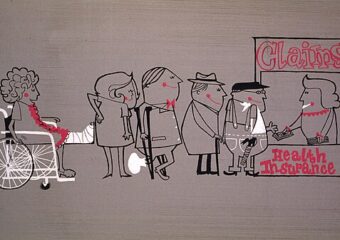Matthew Thomas
Simon & Shuster
New York
2014
620 pages
According to the Art:
This novel covers a sixty–year span of a woman’s life and how the period during her husband’s early-onset Alzheimer’s disease affected the trajectory of her life as a spouse, a mother, a nurse, and a person with dreams and ambitions. Insights are offered on family relationships, daily life, and health care delivery and financing. How denial manifests and evolves is explored, and how grace can come to the fore is rendered.
Synopsis:
In 1951, Eileen Tumulty, the novel’s main character, was nine years old and living with her Irish immigrant parents in the Woodside section of Queens, New York. The novel follows Eileen straight through the next sixty years, but concentrates on the years covering the time of her husband’s Alzheimer’s disease.
Eileen was forced to learn how to manage a household at a very young age when first her mother was kept in a hospital for eight months after a hysterectomy, and then again when her mother became incapacitated by alcoholism. Eileen had reason to think this life was her destiny until she accompanied her father to a better part of Queens. There she saw “places…that contained more happiness than ordinary places did.” She concluded, “unless you knew that such places existed, you might be content to stay where you were.” (pp. 15-16) Eileen’s ambition was ignited. While continuing to manage the household and care for her mother, she does well in school, becomes a nurse, and eventually moves up the nursing management at various hospitals.
Eileen’s ambitions encompassed ideas on her eventual mate. She chooses Ed Leary despite hoping for someone who was not quite so Irish and not quite so much of the same place. Ed was a promising neuroscience graduate student who she thought could be a high achiever with the right motivation: “If there was anything she could help him with, it was thinking big.” (p. 97) Her motivation was not enough and neither were the many offers he received from life science companies. He became a professor at a local community college. He had a passion for teaching students who attend community colleges and he could never see himself anywhere else—for love or money. Ed’s intransigence frustrated Eileen, but she accepted it and plowed ahead. She studied the possible ways of escaping the old neighborhood and also delivered a son, Connell, she thought she’d never have after years of futile efforts.
It doesn’t go smoothly. While she is getting surer of where they would go, Ed begins to exhibit disconcerting behaviors. For them to live in Bronxville, Eileen will have to accept a house that needs a lot of money and attention to rehabilitate. The remainder of the story is about how Eileen simultaneously manages Ed’s rapid deterioration from what eventually is diagnosed as Alzheimer’s disease, her job requirements, and a son progressing from adolescence through college.
Analysis:
We Are Not Ourselves touches on many of the aspects involved in prolonged illness including the daily struggles managing the care of someone with progressive dementia, complexities of health care delivery systems, frustrations with byzantine health care coverage, and threats to relationships among the individual family members, and the grace that can manifest during the bleakest moments. The author does not dwell on all these issues, but gives them enough attention so that their effects will be recognizable to many readers who have experienced them. In doing so, he was able to draw from his own experiences with his father who was stricken with early onset Alzheimer’s disease.
While epic in form, the novel offers two particular insights on the dementia experience. One centers on all the minute–by–minute struggles Alzheimer’s can thrust upon its sufferers and their caregivers. The other concerns the many forms denial can take and how they can manifest at different times during the course of an illness.
The novel presents a few scenes that atomize some of the exhausting and exasperating daily events of Alzheimer’s patients and their caregivers in ways that let readers experience the moment rather than merely witness it. An example is a scene that involves the herculean efforts Eileen needed just to get Ed upstairs and then bathed.
On the way up the stairs that night, he stopped on every step. She had to follow closely behind him and tap a leg to indicate which one was next, then lift it for him. He was frantic when his foot was in the air. They proceeded at a glacial pace, and then he stopped and simply wouldn’t budge, despite how hard she pushed his leg, which still had considerable strength in it, the atrophy notwithstanding. She couldn’t get him to let go of the banister…by the time they reached the top, they were both exhausted.
p. 503
Then, after a lot more effort and energy were expended to get Ed out of the bathtub, alas to no avail, Eileen is bereft.
He was in a kind of agony of fatigue now. He didn’t want to resist her, but he couldn’t help himself. He wanted to sit and he couldn’t sit; he wanted to leave and he couldn’t leave. He somehow had the strength to stand, though she knew he couldn’t do it forever, he would eventually fall like a felled tree. She sat on the tile floor and looked at him in his nakedness. ‘Please, God, tell me what to do,’ she said aloud.
p. 504
Explored to a greater extent is denial. Denial is often spoken of in the singular. Through this novel, the author breaks denial down into the different forms it can take at different times during a prolonged illness. In following Eileen from well before the time Ed first begins to show signs of dementia until his death, we see how she experiences four forms of denial over time: 1) denial about Ed having Alzheimer’s disease; 2) denial about whether Alzheimer’s is actually a disease; 3) denial about Ed’s continued functioning as a full family member during late stages of disease; and 4) denial about needing help with Ed’s care. The author gives us insights on each of these forms of denial, and in making Eileen a nurse shows us how medical professionals are just as likely to succumb to it as anyone else.
Eileen resisted the possibility that Ed’s behaviors that she knew as a nurse could be caused by Alzheimer’s disease. She also denied the consequences an Alzheimer’s diagnosis for Ed would mean to her plans for getting out of the old neighborhood. Even though the root of Ed’s problems and their consequences were right in front of her, the reality of Ed’s disease still had to sneak up on Eileen from behind.
The dawning came all at once, though it felt as if it had been heading her way for a while, like a train she’d heard whistle from miles off that was now flying past and kicking up a terrible wind. Still, she couldn’t pronounce the sentence in her head, ‘Ed has…’ because it was impossible that he had it.
pp. 309-310
This first realization was tentative, but enough to motivate Eileen to submit Ed for a medical examination. During the work up, she wavers and wonders why she is subjecting Ed “in the quiddities of his middle age to a man who would be looking for any sign of deviation from a norm that was probably arbitrary in the first place.” (p. 317) Eileen’s denial had taken another form in doubting the existence of Alzheimer’s as a disease. Ed was just a bit off as can happen to people as they age and she could accommodate his behaviors. Eileen eventually veered away from this notion because, “It was so obvious now that he had Alzheimer’s. The news felt old already, somehow.” (p. 323)
Eileen may have eventually accepted the diagnosis, but she was yet to face two more forms of denial. One had to do with the role Ed played as the father of her son. When Ed’s mental deterioration had progressed far beyond where he could provide fatherly advice to his son, Eileen still believed and insisted that he should. Her denial became evident from her reaction to learning that Connell had sought some fatherly advice from a former teacher (Mr. Corso) that his father could no longer offer.
That’s something you bring to your father. He’s still your father…Your father is still the person to go to with this. I don’t care how great Mr. Corso is. Is he King Solomon? Is he Marcus Aurelius? If not, then you talk to your father. He’s still here.
pp. 475-476
The last denial Eileen experiences and eventually overcomes had to do with her insistence that she did not need help managing Ed’s care, especially since she was a nurse, and a very good nurse at that. She was to hit several walls before she could accept help, and even then it was a bitter pill to swallow.
And the hardest truth was that—no matter how good a nurse she thought she was; no matter that she’d proved…she could do the work of three nurses; no matter that she wanted to believe she could give him better care than anyone else could—she wasn’t sure anymore that a nursing home wouldn’t be better for him…She had run up against her limit.
pp. 510-511
Stories featuring a prolonged illness condition often involve characters that exhibit heroism and grace. This one is no different on those counts. Eileen exhibits heroism throughout the story as she carries her family on her back, and as she exhibits a level of grace nobody could be expected to on the many occasions a certain dream or ambition had been dashed.
Also:
A version of this review is also posted here at the NYU Literature, Arts and Medicine Database.



